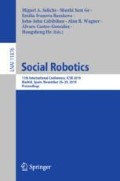Abstract
Social interaction through telepresence robots can be challenging for a robot operator due to lack of spatial awareness caused by limited idiothetic cues and narrow field of view of a robot’s camera. We explore the use of a third-person perspective, popular in video game design, to provide missing spatial cues to remote robot operators. We present the design and implementation of Third Eye, a system that enables controlling telepresence robots through a third-person view. Third Eye comprises a controllable third-person camera with a wide field of view, attached to a robot, and bimanual controls for remote operation. Observations from a user study show that Third Eye enabled the robot operators to have a better awareness of the robot ‘bodies’ they controlled. This, in turn, afforded new behavior for operators. In addition, the camera design supported ecologically valid interaction for social telepresence. Quantitative data shows that Third Eye has comparable navigation efficiency to existing systems.
Access this chapter
Tax calculation will be finalised at checkout
Purchases are for personal use only
References
United Nations. Department of Economic and Social Affairs - Population Division: International Migration Report 2017 (ST/ESA/SER.A/403) (2017)
Kristoffersson, A., Coradeschi, S., Loutfi, A.: A review of mobile robotic telepresence. Adv. Hum.-Comput. Interact. 2013, 1–17 (2013). https://doi.org/10.1155/2013/902316
Chen, J.Y.C., Haas, E.C., Barnes, M.J.: Human performance issues and user interface design for teleoperated robots. IEEE Trans. Syst. Man Cybern. Part C (Appl. Rev.) 37, 1231–1245 (2007). https://doi.org/10.1109/TSMCC.2007.905819
Coltin, B., Biswas, J., Pomerleau, D., Veloso, M.: Effective semi-autonomous telepresence. In: Röfer, T., Mayer, N.M., Savage, J., Saranlı, U. (eds.) RoboCup 2011. LNCS (LNAI), vol. 7416, pp. 365–376. Springer, Heidelberg (2012). https://doi.org/10.1007/978-3-642-32060-6_31
Keyes, B., Casey, R., Yanco, H.A., Maxwell, B.A., Georgiev, Y.: Camera placement and multi-camera fusion for remote robot operation. In: IEEE International Workshop Safety, Security Rescue Robotics, pp. 22–24 (2006)
Takayama, L., Marder-Eppstein, E., Harris, H., Beer, J.M.: Assisted driving of a mobile remote presence system: system design and controlled user evaluation. In: IEEE International Conference on Robotics and Automation. pp. 1883–1889. IEEE (2011). https://doi.org/10.1109/ICRA.2011.5979637
Adams, E.: Fundamentals of Game Design (2013). https://doi.org/10.1017/CBO9781107415324.004
Hughes, S., Manojlovich, J., Lewis, M., Gennari, J.: Camera control and decoupled motion for teleoperation. In: IEEE International Conference on Systems, Man and Cybernetics, pp. 1339–1344. IEEE (2003). https://doi.org/10.1109/ICSMC.2003.1244597
Lima, P., et al.: RoboCup 2004 competitions and symposium: a small kick for robots, a giant score for science. AI Mag. 26, 36–61 (2005). https://doi.org/10.1609/AIMAG.V26I2.1812
Saakes, D., Choudhary, V., Sakamoto, D., Inami, M., Lgarashi, T., Igarashi, T.: A teleoperating interface for ground vehicles using autonomous flying cameras. In: International Conference on Artificial Reality Telexistence (2013). https://doi.org/10.1109/ICAT.2013.6728900
Seo, S.H., Rea, D.J., Wiebe, J., Young, J.E.: Monocle: interactive detail-in-context using two pan-and-tilt cameras to improve teleoperation effectiveness. In: RO-MAN 2017 - 26th IEEE International Symposium on Robot and Human Interactive Communication (2017). https://doi.org/10.1109/ROMAN.2017.8172419
Johnson, S., Rae, I., Mutlu, B., Takayama, L.: Can you see me now?: how field of view affects collaboration in robotic telepresence. In: Proceedings of the 33rd Annual ACM Conference on Human Factors in Computing Systems - CHI 2015, pp. 2397–2406. ACM Press, New York (2015). https://doi.org/10.1145/2702123.2702526
Kress, G., Almaula, H.: Sensorimotor requirements for teleoperation. FMC Corporation, San Diego, CA, Report R-6279 (1988)
Scribner, D.R., Gombash, J.W.: The Effect of Stereoscopic and Wide Field of View Conditions on Teleoperator Performance (1998). http://www.dtic.mil/docs/citations/ADA341218
Giudice, N.A., Tietz, J.D.: Learning with virtual verbal displays: effects of interface fidelity on cognitive map development. In: Freksa, C., Newcombe, N.S., Gärdenfors, P., Wölfl, S. (eds.) Spatial Cognition 2008. LNCS (LNAI), vol. 5248, pp. 121–137. Springer, Heidelberg (2008). https://doi.org/10.1007/978-3-540-87601-4_11
Chesher, C.: Neither gaze nor glance, but glaze: relating to console game screens. SCAN J. Media Arts Cult. 1, 98–117 (2004)
Black, D.: Why can i see my avatar? embodied visual engagement in the third-person video game. Games Cult. 12, 179–199 (2015). https://doi.org/10.1177/1555412015589175
Luff, P., Heath, C., Kuzuoka, H., Hindmarsh, J., Yamazaki, K., Oyama, S.: Fractured ecologies: creating environments for collaboration. Hum. Comput. Interact. 18, 51–84 (2003). https://doi.org/10.1207/S15327051HCI1812_3
Morita, T., Mase, K., Hirano, Y., Kajita, S.: Reciprocal attentive communication in remote meeting with a humanoid robot. In: Proceedings of the Ninth International Conference on Multimodal Interfaces - ICMI 2007, pp. 228–235. ACM Press, New York (2007). https://doi.org/10.1145/1322192.1322232
Guiard, Y.: Asymmetric division of labor in human skilled bimanual action: the kinematic chain as a model. J. Mot. Behav. 19, 486–517 (1987)
Kiselev, A., Kristoffersson, A., Loutfi, A.: The effect of field of view on social interaction in mobile robotic telepresence systems. In: ACM/IEEE International Conference on Human-Robot Interaction, pp. 214–215. ACM (2014)
Arthur, K.W.: Effects of field of view on performance with head-mounted displays (2000). http://wwwx.cs.unc.edu/Research/eve/dissertations/2000-Arthur.pdf
Newman, J.: The myth of the ergodic videogame. Game Stud. 2, 1–17 (2002)
Kirsh, D., Maglio, P.: On distinguishing epistemic from pragmatic action. Cogn. Sci. 18, 513–549 (1994). https://doi.org/10.1207/s15516709cog1804_1
Acknowledgements
We thank Dr. Jason Nolan for his insights and for lending his equipment for research. We also thank Tamara Mahbubani, Syeda Zahra, Nabeel Ahmed, Farisa Hossain, Victor Alexandru, and Ronak Maru for their collaboration. This research was supported through grants from the Social Sciences and Humanities Research Council of Canada, the Canada Research Chairs Program, the Canada Foundation for Innovation, and the Ontario Ministry for Research and Innovation.
Author information
Authors and Affiliations
Corresponding author
Editor information
Editors and Affiliations
Rights and permissions
Copyright information
© 2019 Springer Nature Switzerland AG
About this paper
Cite this paper
Tarun, A.P., Baig, N.M., Chang, J.(K., Tanvir, R., Shihipar, S., Mazalek, A. (2019). Third Eye: Exploring the Affordances of Third-Person View in Telepresence Robots. In: Salichs, M., et al. Social Robotics. ICSR 2019. Lecture Notes in Computer Science(), vol 11876. Springer, Cham. https://doi.org/10.1007/978-3-030-35888-4_66
Download citation
DOI: https://doi.org/10.1007/978-3-030-35888-4_66
Published:
Publisher Name: Springer, Cham
Print ISBN: 978-3-030-35887-7
Online ISBN: 978-3-030-35888-4
eBook Packages: Computer ScienceComputer Science (R0)

